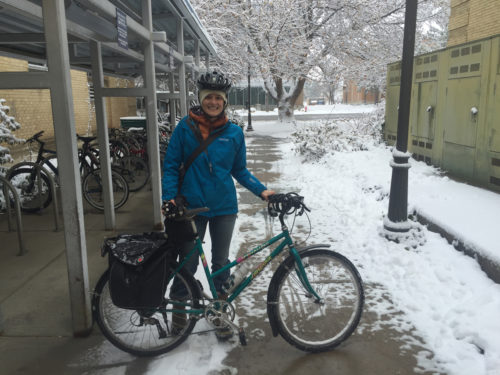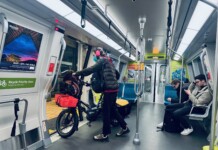By Lou Melini — Utah State University may be the younger sibling to the University of Utah, but when it comes to bicycle programs, USU is the leader with the Aggie Blue Bike program. I had the pleasure to write a commuter column about the program coordinator, Stephanie Tomlin.

Cycling Utah: Stephanie, tell me about your connection to USU and Aggie Blue Bikes.
Stephanie Tomlin: I am the program coordinator of Aggie Blue Bikes, as well as a graduate student at Utah State University. I am pursuing an M.S. in Bioregional Planning, which is large-scale, regional planning and analysis, from the College of Landscape Architecture and Environmental Planning. My thesis work is on alternative transportation connectivity. I am working to understand the importance of connecting bicycle, pedestrian and public transportation networks on a regional scale, such as the Cache Valley region that includes the city of Logan and the surrounding cities of the Cache Valley.
C.U.: Given your association with Aggie Blue Bikes I assume that you are frequently seen riding the roads of Logan. Tell me about your bike commute to USU and bike commuting in Logan.
S.T.: I live a few miles from campus and commute on my bike every day. I have never had a University parking pass for the 3.5 years I have been here. Similar to the University of Utah, Utah State is located on the foothills of surrounding mountain range, making the commute uphill on the way to school and downhill on the way back. I commute year round and have learned through experience about the bike friendly roads in the area, as well as those that are less bike friendly. Logan and all of Cache Valley has very little road cycling infrastructure to speak of. However, we have very wide roads and a network of low traffic streets that make bicycle commuting rather enjoyable. We have a few multi use paths as well, that are good for commuting and leisure riding. I use one of those paths, the Boulevard trail, to get to work every day. The Logan city council just passed the first Bike and Pedestrian Master plan for the city of Logan. That plan makes recommendations for more on street bike lanes, as well as multi use paths.
I find it easy and enjoyable to commute in Logan, however, I would bike commute just about anywhere, so I’m not sure if I am a good spokesperson for whether Logan is a good place to bike commute. Not all roads are bike friendly, but many are. The wide roads, short distances between most major destinations and relatively limited traffic (on key roads) make it manageable! I always avoid Main Street as it is the main thoroughfare though Cache Valley. There is no shoulder and 5 lanes of traffic to contend with. There are also many really beautiful road rides throughout the valley. The wetlands just west of town create a maze of visually stimulating views with low traffic roads. Ideal conditions for a good road ride.
C.U.: In my humble opinion, it takes a special person to be a dedicated bike commuter. Was there anything that sparked your choice to commute by bike?
S.T.: I started commuting by bike due to a class I took on the history and future of oil in the U.S. in the sophomore year of my undergraduate degree, at Westminster College in Salt Lake City. I was struck by this class and was genuinely concerned about this country’s addiction to oil… I had always enjoyed leisure bike riding and decided I would lessen my personal addiction to oil by trying to bike commute. I was surprised by how much I enjoyed bike commuting and as a result, I never looked back. In fact, from there I became interested in bike advocacy and in bike planning. I wanted to show others how great bike commuting could be. I became Westminster College’s first bike coordinator and helped Westminster start a bike collective.
C.U.: What keeps you from bike commuting?
S.T.: My boyfriend and I commute primarily by bike and only have one car between the two of us. There are very few things that keep me from bike commuting. I even commuted today (Ed. Note- December 14th,, 2015) with 5 inches of new snow on the ground. Traffic doesn’t usually deter me, although I’ll avoid busy roads, if possible. I do have a dog, so sometimes I can’t ride my bike if I need to transport her:). I find bike commuting to be more efficient than car commuting in Logan. Even with my busy schedule, I bike commute to save time while getting exercise. I joke about how I bike commute because I am lazy – when I ride my bike I don’t have to wait for a bus or try and find parking, which means that I can leave my house a little later in the morning.
C.U.: Logan is quite a bit colder than Salt Lake City most winter days. Do you have any tips for cold weather riding?
S.T.: I love winter riding; it’s a whole new adventure. Layering and visibility are the two major trips for winter riding! I make sure to wear layers of clothing that I can take off if I need to. My great winter gloves are my favorite piece of clothing, as my hands get very cold easily. Good gloves keep me in good spirits. I use Black Diamond Impulse gloves for commuting in the winter. Visibility is also a key, which includes being seen by drivers and being able to clearly see the road with a set of good lights. Winter means shorter days, often making both my morning evening commutes in the dark. The lights I use are the Spaceship 3 (front) and the Radbot (rear) from Portland Design Works I have also come to terms with the fact that I will probably fall in the winter, and that’s OK. Fortunately it is an uncommon event. I try to approach winter riding as a learning experience-what is the best way to stop in snow, and how does snow really effect my bike handling.
C.U.: What amenities does USU have to accommodate bikes?
S.T.: USU allows bikes throughout campus. Right now we don’t have many bike specific paths throughout campus. We do have USU specific sharrows that were designed in-house to help delineate areas where bikes should be and where they should not be. We will be launching a pilot program to experiment with different ways to create bike specific pathways throughout campus, which will be an exciting improvement. USU is a primarily walking campus (34% of the transportation mode split, as opposed to cycling at 7%) so the USU planners are making sure that we maintain a robust sidewalk network for pedestrians. There is a bike lane to get onto campus from the west side of campus, and we are working on putting in bike lanes on the other major entry points to the campus as well. USU has ample bike parking throughout the campus, however we could have more covered bike parking and storage.
C.U: I looked at the website for Aggie Blue Bikes (www.usu.edu/abb/) but tell me the history of the program and your involvement.
S.T.: ABB started in 2005, by a group of individuals at the university concerned about Cache Valley’s air quality. I got involved with ABB when I was hired as the program coordinator in 2012. As the website states, Aggie Blue Bikes’ mission is to get more people on more bikes more often. We do this through bicycle education, lending and advocacy. We lend bicycles out to students, faculty and staff for up to three months at a time. We also offer day rentals, aimed more for specific uses (mountain bikes, tandems, unicycles, competition road bikes). And finally, we have 5 tool boards available for students to use to maintain their personal bikes – we can walk students through repairs if they need assistance.
ABB started in 2005 with seven rentals bikes, one mechanic and zero student tool boards and since has grown to over 345 rental bikes (of which 85% are rented out at any given time including the winter), five student tool boards, 4 part time mechanics, one 75% shop manager and one 75% time program coordinator. We are primarily student fee funded – every student pays $2.75 per semester into the Aggie Blue Bikes fund. We are an important resource for the USU community and we are always looking to expand and improve, we never have been able to keep up with demand! All of our rental bikes are donated that we refurbish, powder coat blue and upgrade (if needed). In order for students to rent a bike from us they have to complete a bike safety quiz and get a 90% on it, which indicates to us that they will ride properly and respectfully.
We recently received a $90,000 shop remodel grant. We just completed the remodel and some much-needed upgrades (new floors, work benches, lighting, bike stands, etc.). Additionally, Aggie Blue Bikes is the lead sponsor of the USU Open Streets Festival. This is a one-day event where we close down 7th North, the main thoroughfare on campus, to vehicular traffic and open it to active transportation. The Open Streets festival encourages people to examine a public space in a new way.
C.U.: Is the Aggie Blue Bike program a unique program or are there other similar programs in Utah or the U.S. How does the program stand out?
S.T.: I think ABB is very unique. I have not encountered another bicycle program that rents bikes out to students to use for three months – free of charge! We are also unique because we have a dedicated student fee supporting our efforts.
C.U.: Where on the USU campus is ABB located?
S.T.: ABB is located in between the Military Science building and the Fieldhouse at USU.
C.U.: Where is the source of most of your donated bikes and parts- from USU students, the surrounding Logan community, or further away from Logan. How would you describe the response for donations?
S.T.: We get our bikes through a few different sources: The USU campus police, the Logan City Police and private donations. The police departments donate bikes to us if they have been abandoned for over 90 days. We are also pleasantly surprised with the number of private citizen donations. I have done very little advertising that we accept donations, but we still receive more donations from private citizens annually than we can turn into Aggie Blue Bikes each year. It’s a great problem to have an overly generous community! We save any kids bikes we receive throughout the year and refurbish them for the annual sub for Santa drive that happens in the community.
C.U.: Are the volunteers that staff Aggie Blue Bikes mostly from campus or from the community?
S.T.: We actually pay our mechanics, but we also have volunteers. We use an AmeriCorps grant to hire all the paid mechanics, which are usually USU students, but not always. Our volunteers are usually USU students, and we have anywhere between 2 – 6 mechanics at a time.
C.U. Thank you Stephanie for your participation in this column.
For more information on Aggie Blue Bikes, visit: www.aggiebluebikes.org
Editor’s Note: Stephanie has moved on to consulting with Fehr and Peers. Aggie Blue Bikes is still going strong.
If you have a suggestion for a commuter profile, have a commuter question, or other comments, please send it to [email protected].












